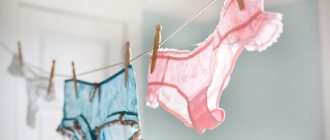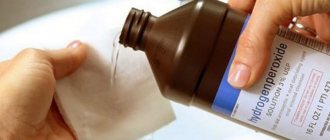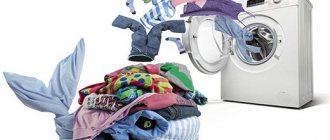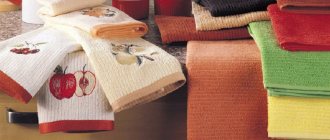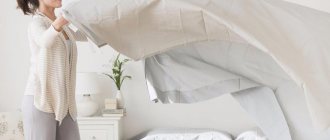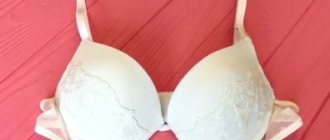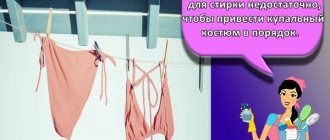Imagine a real-life incident. You bought chic lace lingerie from the online store Evasecret.ru, and if you used to be a beauty queen, then you look like a goddess in it! It is not worth mentioning that seeing an unearthly beauty, a man quickly begins to lose his sanity, and at any opportunity he wants to touch his Aphrodite.
Three months have passed... The ideal set, which was recently in the unquestioned status of a favorite, now often remains in the closet. Why? Simple to the point of triviality. It doesn't produce the WOW effect it did the first time after purchase. The point is not that the style is boring or the bra suddenly went out of fashion.
Over time, any clothing begins to slowly but surely lose its original appearance, colors become dull, freshness and the sheen of novelty disappear. But we are not women, if we simply gave up on any difficulty, every housewife decides how to bleach gray underwear at home.
Of course, you can honorably bury your favorite item in the closet next to a heap of other lace sets that suffered a sad fate earlier. Good quality clothes are not cheap. With a reasonable approach to finance, filling your closet with things until better times is not rational. A beloved set should faithfully serve a woman, and not gather dust in the closet.
Lace, silk, and openwork works of art can be taken to the dry cleaner closest to your home. But, firstly, not everyone will take on such things that require ultra-delicate handling. Secondly, many girls are simply embarrassed to “expose their underwear.” Intimate items for personal use may have piquant details that risk becoming a topic for gossip and heated discussions among complete strangers. It is unlikely that anyone will like this.
Modern girls come to the aid of methods that allow them to bleach gray underwear at home effectively and, importantly, without unnecessary shock to their wallet. Many generations ago, women were worried about the same concerns that they are today. Therefore, why not take some life hacks for personal use; they have already passed the most severe test of time.
Even the most elegant, graceful set can easily be ruined by yellowish stains and all shades of gray. The most vulnerable in this regard are white lace bras and panties, which are classified as must-haves. They are universal, especially necessary in the season of light summer dresses, sundresses, skirts and shorts.
Features of washing clothes by type of fabric
Women's underwear is made from synthetic and natural fabrics. Often materials are combined in one product. For example, the cups are made of natural fabric, and the straps are made of elastane or polyester. When choosing a bleaching method, you should focus on the laundry tags and take into account the characteristics of the material. Proper washing and recommendations from the table will help prevent white items from discoloring.
Table - Features of washing underwear depending on the type of fabric
| View | Textile | Peculiarities |
| Synthetics | — Polyester; - polyamide; - elastane | — Washable at 30-40°C; - do not tolerate spinning and drying in a washing machine; - resistant to bleach; - do not shed |
| Natural | - Cotton | — Withstands high temperatures (60-90°C); — sheds and loses its color, so sorting by color is mandatory; - resistant to bleaches; — tolerates machine washing in the absence of lace inserts |
| — Silk | — Hand wash only; — water temperature no more than 20°C; — chemical bleaching is not allowed; - do not squeeze or subject to mechanical impact | |
| — Satin satin (combines silk and cotton fibers) | — Washing temperature — 40-45°С; — no bleaches are used; - washable separately from other items |
It is recommended to wash underwear without boiling. You especially should not resort to such a radical method when bleaching lace, synthetic and silk underwear. Boiling, as a last resort, is used for cotton and linen fabrics. The procedure is carried out in an enamel bowl with a small amount of powder and bleach. Boil for no more than 40 minutes.
Boiling
The boiling method is only suitable for white linen made from natural cotton or linen. Fabrics with a share of synthetics, lace and delicate items are bleached strictly without boiling. And even super-strong cotton fabrics will not thank you for your abuse of boiling water. It is better not to boil for longer than 30-40 minutes over low heat. And try not to get burned!
An alternative to boiling is washing at high temperatures or soaking in boiling water, for example, with Persol bleach.
How to whiten your bra and panties: 3 ways
To remove stains, yellowness or grayness, you can use professional bleaches or folk remedies. It should be borne in mind that aggressive substances will remove stains and return the previous white color, but their high concentration can deform the product. On the contrary, “weak” substances or their insufficient concentration will not give the expected result. Therefore, when choosing what to wash yellowed underwear with, you need to evaluate the degree of contamination and the strength of the fabric.
Bleaches
Household chemical stores offer chemical bleaches for various types of fabric. Cotton and linen products are successfully bleached - they are less susceptible to aggressive substances. For a synthetic bra, you should select a product with the appropriate labeling. The active ingredients in bleach are usually bleach and oxygen.
- Chlorine-containing. The most popular and affordable product containing chlorine is bleach. Modern manufacturers use fragrances that imitate peach, apple, and chamomile to fight off the smell of chlorine. The product is added to the washing powder during soaking in the ratio of one tablespoon per 3 liters of cold water. Linen should be kept for no more than 20 minutes.
- Oxygen. Less aggressive bleaches contain sodium percarbonate, which acts as an oxidizing agent. Available in the form of powders or liquids. Apply before washing. The amount of product indicated on the package is dissolved in warm water (each manufacturer recommends its own dosage). The linen is soaked for one hour, then rinsed and washed.
Professional bleaches will help you quickly deal with yellowness and grayness. However, it should be borne in mind that bleach negatively affects fabric fibers and can cause allergies, so chlorine-containing substances should be used extremely rarely. Thorough rinsing will prevent skin irritation when wearing underwear.
Oxygen bleaches can be added every two washes; they do not damage the fabric. The main advantage is safety. The product does not cause allergies and is environmentally friendly. Bleach should not be used on silk, wool and leather, or on items with wooden fittings.
Ammonia
According to reviews on women's forums, ammonia (ammonia) is an effective whitening agent. You can find ammonia at your nearest pharmacy at a modest price. A solution of ammonia is suitable for bleaching any fabric (even silk). The product is applied in four steps.
- Pour two tablespoons of alcohol into 1 liter of cold water and stir.
- Immerse your underwear in the solution.
- Leave for no more than three hours.
- Wash things with powder.
To enhance the effect when soaking, it is recommended to add two tablespoons of turpentine. The pungent smell of ammonia can be easily removed by adding conditioner during washing.
Peroxide
Hydrogen peroxide is good for synthetic fabrics and will whiten grayed linen. It is necessary to soak the washed items in a peroxide solution for half an hour (five tablespoons per 2 liters of water). It is important to ensure that the laundry completely covers the solution, otherwise yellow stains will remain.
A combination of ammonia, peroxide, salt and powder will help remove gray from white panties and bra. In 10 liters of water you need to dissolve two tablespoons of washing powder and eight tablespoons of salt. Pour in three tablespoons of peroxide (3% solution) and two tablespoons of alcohol. The laundry is soaked for four hours and then washed with laundry soap.
Chemical bleaches
If strong stains appear on the surface of the laundry that cannot be removed with folk remedies, you will have to use a more effective solution - household chemicals. There are three groups of bleaches:
- Oxygen.
- Optical.
- Chlorine-containing.
Optical
Such substances are able to reflect light due to the presence of special additives in the composition. This promotes good whitening of dirty surfaces.
Many washing powders also contain reflective particles that provide whiteness. However, they are not able to cope with heavy pollution. With frequent washing with similar products, colored laundry begins to fade.
Chlorine-containing
Often, laundry is washed with chlorine-containing products such as bleach. The popularity of this household chemical is due to its affordable price and high efficiency. However, it has a negative effect on thin fabric and can damage its structure.
After several washes, the surface gets gaps and holes. To prevent rapid wear, you need to dilute the solution with water.
This type of bleach is not suitable for wool or silk items. They also cannot be used for automatic machine washing.
Oxygen-containing
Representatives of this group are considered the most gentle of all the others. They do not destroy the structure of the fabric, do not harm the fibers and at the same time effectively restore the shade. Such products are suitable for processing any fabrics, including delicate items made of silk and lace.
Among the popular manufacturers of household chemicals for washing clothes are:
- Bos Plus Maximum.
- Vanish.
- Amway SA8.
- Synergetic.
When choosing a suitable product, you need to pay attention to the specifics of the body and the tendency to allergic reactions. However, most formulations are hypoallergenic.
Anti-pollution
It is easier to deal with a gray or yellow tint than to remove yellow sweat stains from underwear. Sweat leaves unsightly streaks, eats into the straps and spoils the overall appearance of your bra and panties. No less annoying are faded spots of purple, pink or yellowish color. Stains must be removed locally, focusing specifically on dirt. Simple bleach is not enough: the product acts completely on the product and, at best, will lighten the stain. Therefore, it is necessary to choose an effective method for each type of stain.
Yellow stains
Household products will help remove yellow stains from your bra and panties.
- Boric acid. Pour two tablespoons of acid into 4 liters of water. Soak the clothes for two hours and rinse.
- Laundry soap. Soak items in cold water for two hours, and then wash problem areas with 72% natural soap. Fill the laundry with hot water, lather and leave for one hour. Wash and rinse things.
- Potassium permanganate. In a washing basin, dilute potassium permanganate to obtain a pale pink solution (approximately 200 g per 10 liters of water). Soak the laundry and cover the container with cling film. When the water has cooled, rinse your items.
For cotton undies, you can combine soap and bleach. First, the stain is soaped and left for 15 minutes. Afterwards, the laundry is washed with the addition of bleach.
If you still haven’t succeeded in bleaching your white panties and bra from yellow stains, or the fabric requires a more delicate approach, you can use citric acid spot-on. The procedure is performed in four steps. It can be repeated, but not immediately, but after the laundry has dried.
- Dissolve one teaspoon of acid in a glass of water.
- Apply the solution to the stains.
- Leave for one hour.
- Wash your clothes with soap or powder.
Video on the topic
Stubborn stains
It is more difficult to remove old yellow stains from a bra or panties. If, after numerous washes with bleach, stains still remain on the clothing, the item may not be repairable. However, it is worth trying acid, alcohol and dish gel.
- Aspirin. Soak the laundry in soapy water. Dissolve the product (two tablets) in a small amount of water and apply to the yellow spots. Leave the clothes for two to three hours, rinse and wash.
- Salt and ammonia. Dissolve alcohol and salt (a teaspoon each) in a glass of water and soak the stain with the solution. Leave for a few minutes and rinse.
- Detergent. Suitable for all types of fabric. Mix half a tablespoon of dishwashing gel with a spoon of baking soda powder. Rub the product into dirty areas with a brush, leave for two to three hours and rinse.
As a last resort, you can try a recipe with denatured alcohol. It is better to experiment on a cotton bra - delicate fabrics may not withstand the action of the solvent. Mix a small amount of denatured alcohol with the yolk to form a thick mass. Apply to stain and let dry. Cut off the resulting crust with a nail file or soak it with a swab containing glycerin. Wash it. If after this the stains have not given up, it means that the linen can no longer be saved.
Faded fabric
It is quite difficult to wash a faded white bra, especially if it has already dried and had time to lie down. The problem should be solved immediately after it is discovered, while the laundry is still damp. There are several ways to get rid of faded stains.
- Soap mass. Mix soap shavings, starch and citric acid (a tablespoon each), add half a glass of salt. Dilute the resulting dry mixture with enough water to form a paste. Apply to the stain and leave for 12 hours, then rinse thoroughly.
- Mustard powder. Suitable for silk. Dilute a tablespoon of powder in 1 liter of water and leave to infuse for one hour. Drain the water into the wash basin and repeat the procedure until you have enough water. Wash your clothes in mustard water as usual.
- Peroxide. Add a tablespoon of peroxide and soda powder to 2 liters of water. Stir the resulting mixture and heat to 70°C (be careful not to boil). Soak the clothes in the heated solution for ten minutes. The laundry must be turned over constantly. Rinse and dry.
When choosing a cleaning method, you should focus on the structure of the material. Dense cotton fabrics can withstand chemicals and high temperatures. It is better not to subject synthetic and silk items to aggressive cleaning methods.
Universal industrial stain removers: table
If you trust store-bought products more, you can choose from the list the one that is suitable specifically for your situation.
| Group | Name Capacity/Average Price | Peculiarities | Flaws |
| The best stain removers for laundry | WIDE HAITER 600 ml/540 rub. |
|
|
| BON (Bon) 250 ml/280 rub. |
|
| |
| DR. BECKMANN (Doctor Beckman) 250 ml/200 rub. |
|
| |
| SODASAN (Sodasan) 200 ml/300 rub. |
|
| |
| VANISH OXI ACTION (Vanish Oxy Action) 3 l/879 rub. |
|
| |
| Products for children's panties and other things | “Umka” 400 g/50 rub. |
|
|
| “Our Mother” 500 ml/305 rub. |
|
| |
| DOMAX “BABY CARE” (Domax Baby Care) 500 ml/280 rub. |
|
| |
| Oxygen bleaches | ECOVER (Ekover) 400 g/320 rub. |
|
|
| SHABONDAMA (Shabondama) 750 g/500 rub. |
|
|
Important: before using an industrial stain remover, you need to study the instructions and follow the instructions in them exactly. Otherwise, the laundry may be damaged.
Lace products
Expensive lace and silk lingerie looks beautiful and seductive. However, happy owners carefully choose how to bleach their lace underwear so as not to deform the fabric or lose the shape of the lace. Two products that you can find in the kitchen are suitable for this.
Vinegar solution
- Add one glass of 9% vinegar to 2 liters of warm water.
- Soak the laundry in the solution overnight.
- Wash as usual.
Soda-salt solution
- Dissolve two tablespoons of salt and soda in cold or warm water.
- Stir thoroughly so that no grains remain in the water.
- Soak the laundry.
- Leave for two to three hours.
- Rinse and wash items as usual.
The vinegar solution will do an excellent job of bleaching silk and satin fabrics, making the white color more saturated, and getting rid of stains. A saline solution is suitable for bleaching a guipure bra. Guipure is made from thin natural threads mixed with synthetic fibers, so the water temperature should not exceed 40°C.
Bleaching, even with natural means, always has a strong effect on the fabric. Therefore, in order not to rack your brains over how to bleach your underwear, you should follow the rules for wearing, washing and caring for your bra and panties. It is better not to wear white underwear under dark clothes and wait until the deodorant has completely dried before getting dressed. Linen washed on time and in compliance with all recommendations will retain its color and shape for a long time.
Soda
It is suitable not only as a baking powder. It can be used to remove many types of contaminants. It is especially effective when processing white fabrics. The stains are soaped again with laundry soap, and after an hour they begin machine washing. The laundry is folded into the drum and a teaspoon is poured into it. soda Then washing proceeds as usual.
Hydrogen peroxide
An antiseptic, which can be purchased at a pharmacy, does an excellent job of removing even stubborn stains on clothes. To whiten lace, dissolve 3 tablespoons in a liter of warm water. peroxide and lower the laundry. Soaking duration is 20–30 minutes. It is important to ensure that the laundry is completely immersed in the solution, otherwise yellow spots will remain on it.
Citrus zest
Other parts of citrus fruits are also useful in bleaching. Both lemon juice and zest have the necessary properties. Orange and grapefruit will also come in handy.
The method is a little longer than with juice, but it also works:
Milk
Simple products work wonders: for example, milk easily removes grayness and even blue ink. Just soak your laundry in it and wait. To speed up the results, periodically wipe the stains and replace the milk with fresh milk.
White vinegar
Housewives use vinegar to rinse clothes and preserve their color. The product can restore the whiteness of panties in several applications:
Boric acid
If you have boric acid in your household, it is also suitable for delicate whitening of underwear. Use the substance in powder form:
Aspirin
An unexpected pharmaceutical product for whitening lace and mesh underwear:
Removing fresh blood stains
If you find fresh traces of discharge on clothing, you must act immediately, since old stains are much more difficult to remove.
First, you need to rinse the item under cold running water using cleaning products. Such products can be either laundry soap or regular dishwashing detergent.
If the water is above 30 degrees, there is a risk that traces of blood will be absorbed into the fabric.
To make things easier to wash, when it is not possible to rinse the laundry right away, soak it in water. Removing fresh stains is much easier than removing dried ones.
How to boil laundry to bleach at home
Boiling is a proven way to return things to their original whiteness. This method can only be used for linen and cotton fabrics. In this case, the following rules must be observed:
- You can boil laundry in a stainless steel container. Enameled containers, such as a ten-liter saucepan, work well.
- Before loading laundry into a pan for boiling, you first need to wait until the powder and other products are completely dissolved, otherwise the effect will not be so strong.
REFERENCE! If laundry soap is added to the water, then grate it first - this will dissolve it faster.
- They boil not only dirty things, but also clean ones to give them freshness and disinfect them.
- It is better not to leave heavily soiled items to boil, otherwise the dirt may be absorbed even more.
- During the boiling process, the contents of the container should be constantly stirred so that the laundry is boiled evenly.
- The frequency of boiling should be 3-4 times a year, not more often. This is due to the fact that this process has a negative effect on tissue.
